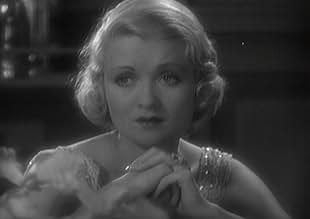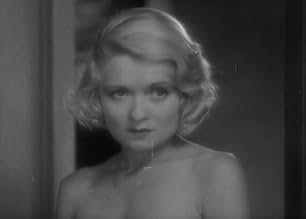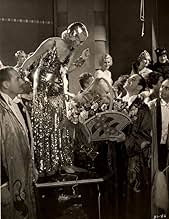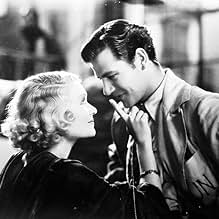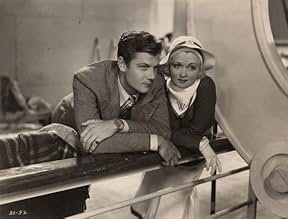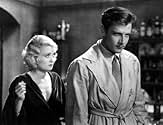अपनी भाषा में प्लॉट जोड़ेंYoung Valerie models for an American painter who tries to make a future in Paris and they fall in love.Young Valerie models for an American painter who tries to make a future in Paris and they fall in love.Young Valerie models for an American painter who tries to make a future in Paris and they fall in love.
- निर्देशक
- लेखक
- स्टार
Emile Chautard
- Doorman
- (बिना क्रेडिट के)
Albert Conti
- Strangeways Party Guest
- (बिना क्रेडिट के)
Carrie Daumery
- Strangeways Party Guest
- (बिना क्रेडिट के)
George Davis
- Charles - Dick's Butler
- (बिना क्रेडिट के)
Julia Swayne Gordon
- Mrs. Strangeways
- (बिना क्रेडिट के)
George Irving
- Doctor
- (बिना क्रेडिट के)
Dolores Murray
- Queen at the Ball
- (बिना क्रेडिट के)
Tom Ricketts
- Elderly Strangeways Party Guest
- (बिना क्रेडिट के)
Marshall Ruth
- Strangeways Party Guest
- (बिना क्रेडिट के)
फ़ीचर्ड समीक्षाएं
An American artist in Paris falls in love with his model and wants to marry her, but she say's no. They argue and part. Bennett is beautiful and bohemian. McCrea is handsome and conventional. They meet again at a wild Artist's ball, Bennett wearing a gown and skull cap of glittering sequins that's a knockout. She's irresistibly charming as she woos herself back into the arms of the grumpy object of her affections.
This was another Bennett blockbuster. Variety's reviewer wrote, "It's from the customary Bennett mold (that) will make each a little less strong at the b.o." Those words proved prophetic. Reviewer also criticized the star's acting, "It's becoming as stereotyped as the stories themselves." I liked Bennett's acting, but what awful posture. On the other hand, Hedda Hopper knows how to stand up straight and keep her hands where they belong, but she can't act. Everyone else acts A-OK. The plot of this "risqué" movie is irrelevant. The only reason to watch it - then or now - is to see Bennett work her magic. That's why she was paid $5000 a week.
This was another Bennett blockbuster. Variety's reviewer wrote, "It's from the customary Bennett mold (that) will make each a little less strong at the b.o." Those words proved prophetic. Reviewer also criticized the star's acting, "It's becoming as stereotyped as the stories themselves." I liked Bennett's acting, but what awful posture. On the other hand, Hedda Hopper knows how to stand up straight and keep her hands where they belong, but she can't act. Everyone else acts A-OK. The plot of this "risqué" movie is irrelevant. The only reason to watch it - then or now - is to see Bennett work her magic. That's why she was paid $5000 a week.
The common law in "The Common Law" is that a girl is better off married than living in sin. That's a message that the Hays Code censors could have gotten behind, but they never could have approved this 1931 film. In 1931, the Hays Code was in effect but the Production Code Administration and its tough boss Joe Breen, which rigidly enforced the Code, didn't come into existence until 1934. As a result, the studios were able to ignore the Code and get away with sexual themes that would soon become utterly unthinkable. This was a necessity in 1931 because sex brought people into the theaters and the industry was desperate to sell tickets during the depths of the Depression.
Valerie West, an American in Paris, makes her living by being the mistress of a rich American, Dick Cardemon, but she dumps him and starts a career as a nude model. She models for a mediocre but rich American painter named John Neville who falls madly in love with her. However, he evidently assumed she was a virgin because he dumps her when he finds out about Cardemon.
Later Valerie manages to pick up John once again at a very sexy Artists' Ball (there's a still photo of the ball in Vieira, "Sin in Soft Focus" (1999), p. 56). This time Valerie and John decide to live together without getting married, but that causes quite a scandal back home. John's snooty family tries to break them up, but...
The film is a very effective attack on the sexual double standard and on American upper-class conspicuous consumption, snootiness, and prudishness. Attacks on the upper class were quite popular in the early 1930's, given people's desperation in the Depression and the natural tendency to blame the rich for what happened. The film also shows that a smart, spunky, and beautiful girl can make very good despite having engaged in lots of free love (not to mention nude modeling) with rich men. Valerie is not punished for all that sin--in violation of the so-called "compensating values" norm later enforced by Breen and the Production Office. That norm would require that she receive some horrible punishment for engaging in extra-marital sex--but quite to the contrary, Valerie comes out just fine.
The film is an exceptionally interesting example of the kind of movies that were made at the beginning of the sound era but before the curtain came down in 1934 on candid treatments of sexual behavior.
Valerie West, an American in Paris, makes her living by being the mistress of a rich American, Dick Cardemon, but she dumps him and starts a career as a nude model. She models for a mediocre but rich American painter named John Neville who falls madly in love with her. However, he evidently assumed she was a virgin because he dumps her when he finds out about Cardemon.
Later Valerie manages to pick up John once again at a very sexy Artists' Ball (there's a still photo of the ball in Vieira, "Sin in Soft Focus" (1999), p. 56). This time Valerie and John decide to live together without getting married, but that causes quite a scandal back home. John's snooty family tries to break them up, but...
The film is a very effective attack on the sexual double standard and on American upper-class conspicuous consumption, snootiness, and prudishness. Attacks on the upper class were quite popular in the early 1930's, given people's desperation in the Depression and the natural tendency to blame the rich for what happened. The film also shows that a smart, spunky, and beautiful girl can make very good despite having engaged in lots of free love (not to mention nude modeling) with rich men. Valerie is not punished for all that sin--in violation of the so-called "compensating values" norm later enforced by Breen and the Production Office. That norm would require that she receive some horrible punishment for engaging in extra-marital sex--but quite to the contrary, Valerie comes out just fine.
The film is an exceptionally interesting example of the kind of movies that were made at the beginning of the sound era but before the curtain came down in 1934 on candid treatments of sexual behavior.
This movie has a lot of interesting things to say about marriage. Primarily its message is that marriage is a social convention. Women get married because marriage offers "protection." The emphasis in this movie is on social protection: marriage will protect women from malicious social gossip and from other lecherous males.
John Neville (Joel McCrea) asks live-in girlfriend Valerie West (Constance Bennett) to marry him because he's "in love." She says she wants to wait because she wants to be sure that their love will last. When she marries, she wants it "to be for keeps." As she says, "I'm really quite an old-fashioned girl -- well, with some modern decorations." Valerie soon changes her mind when John's sister (played by Hedda Hopper) arranges a boat cruise inviting his father (played by Walter Walker), her former lover (played by Lew Cody), and another girl interested in John. Unable to stand the social awkwardness, the gossip, and the blatant advances of her former beau, Valerie decides that perhaps getting married even though she's not sure it will last is the best way to go after all.
A critique about society's views of women and marriage, this movie also boasts strong performances by Hedda Hopper as John's sister and Walter Walker as John's father. Hedda is particularly good as the nasty, bitchy hypocrite Claire Collis, who does all she can to break John and Valerie up while feigning ignorance about it. Constance Bennett also gives a strong performance as Valerie.
Being that this was a pre-Code and Constance's character was supposed to be a nude model, I had hoped that they might have snuck in some flashes of skin. Unfortunately, they don't. Even the portraits of Constance nude cover up the private areas. There is some nudity in the film though, a long shot of a group of presumably naked women posing on a float during a raucous French party.
Given the performances and the interesting message the movie has, I'd give it a 7/10.
John Neville (Joel McCrea) asks live-in girlfriend Valerie West (Constance Bennett) to marry him because he's "in love." She says she wants to wait because she wants to be sure that their love will last. When she marries, she wants it "to be for keeps." As she says, "I'm really quite an old-fashioned girl -- well, with some modern decorations." Valerie soon changes her mind when John's sister (played by Hedda Hopper) arranges a boat cruise inviting his father (played by Walter Walker), her former lover (played by Lew Cody), and another girl interested in John. Unable to stand the social awkwardness, the gossip, and the blatant advances of her former beau, Valerie decides that perhaps getting married even though she's not sure it will last is the best way to go after all.
A critique about society's views of women and marriage, this movie also boasts strong performances by Hedda Hopper as John's sister and Walter Walker as John's father. Hedda is particularly good as the nasty, bitchy hypocrite Claire Collis, who does all she can to break John and Valerie up while feigning ignorance about it. Constance Bennett also gives a strong performance as Valerie.
Being that this was a pre-Code and Constance's character was supposed to be a nude model, I had hoped that they might have snuck in some flashes of skin. Unfortunately, they don't. Even the portraits of Constance nude cover up the private areas. There is some nudity in the film though, a long shot of a group of presumably naked women posing on a float during a raucous French party.
Given the performances and the interesting message the movie has, I'd give it a 7/10.
Joel McCrea plays an American artist living in Paris. He hires a woman (Constance Bennett) to be his nude model and eventually they fall in love. However, when he learns she has a tawdry past, he runs off to brood. Later, at debaucherous party, they meet once again. Soon, he asks her to marry him--she suggests they cohabitate to see if he really wants her. When the scandal of this relationship reaches his rich parents' ears, his mother schemes to pull the two lovers apart. However, in a strange scene, McCrea's on-screen father says that he heartily approves of the pair living together and wishes them the best! What happens next? See this odd film for yourself to find out for yourself.
If you haven't guessed, this film is CLEARLY an example of Pre-Code sensibilities. What I mean by that is that up until mid-1934, Hollywood's sense of morality was FAR looser than most folks would believe today. This was especially true from 1930-34--where adultery, premarital sex, violence, foul language, abortion and partial nudity were not terribly uncommon on the screen. But this moral code was not in line with America and soon folks started avoiding movies and ticket sales dropped. Soon, to lure back families, a strengthened Production Code was enforced--and films became, at times, a bit over-sanitized--but very family-friendly. Because of all this, there is zero chance this film could have been made after the Code was enforced--at least not without LOTS of revisions as well as a clear message that such immorality MUST be punished. But here in "The Common Law", the villains are NOT people who flaunt morality but the narrow-minded folks who don't approve and who, in some cases, are simply hypocrites! So is it worth seeing? Well, the film is well-acted and interesting. And, I do enjoy seeing many of the Pre-Code films because they are so strange and confusing--and entertaining!! So, I'd say this is very much worth seeing and a fine example of the genre.
If this isn't a plot that screams 'I'm a Pre-Code film!', nothing is!!
If you haven't guessed, this film is CLEARLY an example of Pre-Code sensibilities. What I mean by that is that up until mid-1934, Hollywood's sense of morality was FAR looser than most folks would believe today. This was especially true from 1930-34--where adultery, premarital sex, violence, foul language, abortion and partial nudity were not terribly uncommon on the screen. But this moral code was not in line with America and soon folks started avoiding movies and ticket sales dropped. Soon, to lure back families, a strengthened Production Code was enforced--and films became, at times, a bit over-sanitized--but very family-friendly. Because of all this, there is zero chance this film could have been made after the Code was enforced--at least not without LOTS of revisions as well as a clear message that such immorality MUST be punished. But here in "The Common Law", the villains are NOT people who flaunt morality but the narrow-minded folks who don't approve and who, in some cases, are simply hypocrites! So is it worth seeing? Well, the film is well-acted and interesting. And, I do enjoy seeing many of the Pre-Code films because they are so strange and confusing--and entertaining!! So, I'd say this is very much worth seeing and a fine example of the genre.
If this isn't a plot that screams 'I'm a Pre-Code film!', nothing is!!
It was said, possibly by David Niven, that Constance Bennett would walk into a room at night to play cards and emerge the next morning looking exactly the same as when she went in. I can believe it. Her beauty, glamor, and freshness are beautifully showcased in "The Common Law" about living and loving (freely) in Paris.
It seems strange that a movie made in 1931 should seem more modern than later films, but we can thank the Hayes code for that. In The Common Law, Bennett, when she's not shacking up with some guy, is a model for an artist, played by boyish Joel McCrea. The two fall in love, go through a breakup and reconcile. She is reticent about getting married. Then McCrea's conniving sister, having heard all the rumors, lures both she and McCrea back to America.
McCrea and Bennett made several films together, and they are a beautiful couple. He's big and wholesome; she's delicate and sophisticated. And of course, they're both incredibly beautiful.
It's always interesting to catch a pre-code movie, and The Common Law is a good one.
It seems strange that a movie made in 1931 should seem more modern than later films, but we can thank the Hayes code for that. In The Common Law, Bennett, when she's not shacking up with some guy, is a model for an artist, played by boyish Joel McCrea. The two fall in love, go through a breakup and reconcile. She is reticent about getting married. Then McCrea's conniving sister, having heard all the rumors, lures both she and McCrea back to America.
McCrea and Bennett made several films together, and they are a beautiful couple. He's big and wholesome; she's delicate and sophisticated. And of course, they're both incredibly beautiful.
It's always interesting to catch a pre-code movie, and The Common Law is a good one.
क्या आपको पता है
- ट्रिवियाThe screenplay was written by John Farrow. Five years later he married actress Maureen O'Sullivan, with whom he had seven children including actress Mia Farrow.
- भाव
John Neville Sr.: You're getting more like your mother every day.
Mrs. Claire Collis: I should think that would make you very happy.
John Neville Sr.: It does. And a little apprehensive.
- कनेक्शनFeatured in Thou Shalt Not: Sex, Sin and Censorship in Pre-Code Hollywood (2008)
टॉप पसंद
रेटिंग देने के लिए साइन-इन करें और वैयक्तिकृत सुझावों के लिए वॉचलिस्ट करें
विवरण
- रिलीज़ की तारीख़
- कंट्री ऑफ़ ओरिजिन
- भाषाएं
- इस रूप में भी जाना जाता है
- Diosas de Montmartre
- फ़िल्माने की जगहें
- पेरिस, फ़्रांस(second unit, background and establishing shots)
- उत्पादन कंपनी
- IMDbPro पर और कंपनी क्रेडिट देखें
बॉक्स ऑफ़िस
- बजट
- $3,39,000(अनुमानित)
- चलने की अवधि
- 1 घं 14 मि(74 min)
- रंग
इस पेज में योगदान दें
किसी बदलाव का सुझाव दें या अनुपलब्ध कॉन्टेंट जोड़ें

